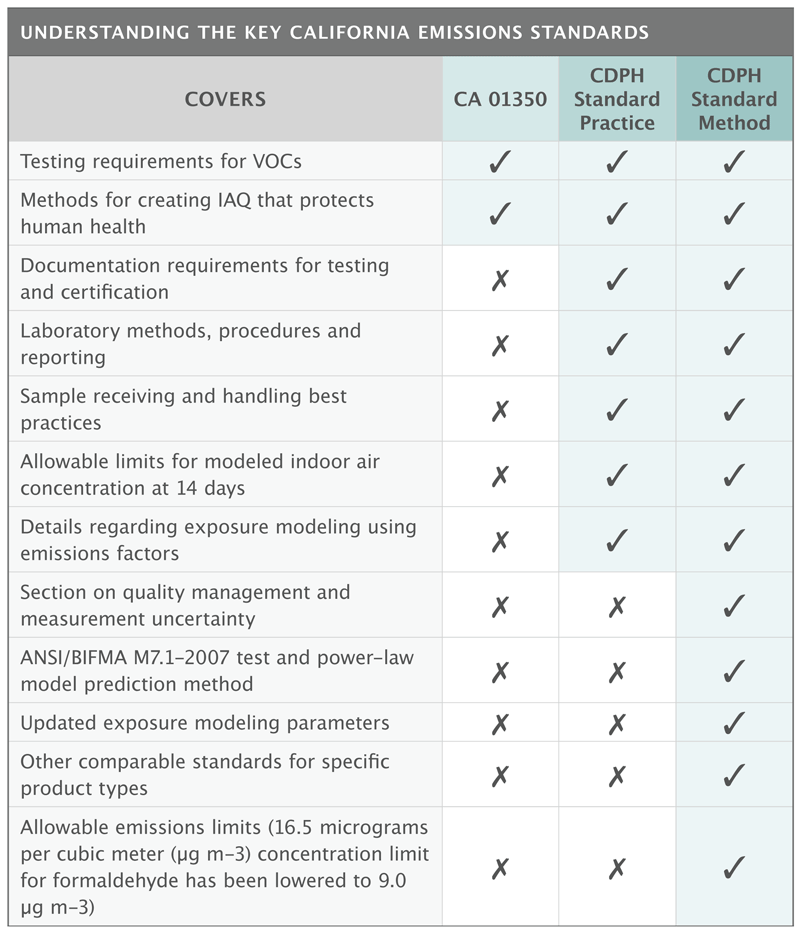LEED v4 bundled what had previously been several separate low-emitting materials credits into one exceedingly complicated credit. LEED v4.1 tries to reduce some of the difficulty of achievement, but much of the complexity remains.
We'll break things down category by category.
Requirement for: Inherently nonemitting sources
What this covers: Stone, ceramic, powder-coated metals, plated or anodized metal, glass, concrete, clay brick, unfinished or untreated solid wood
Testing methods used: No VOC emissions testing necessary if products do not include coatings, binders, or sealants that include organic chemicals
Requirements for: General Emissions Evaluation
What this covers: Interior paints and coatings applied on site; interior adhesives and sealants applied on site (including flooring adhesive); flooring; ceilings; walls; and thermal and acoustic insulation
Testing methods used: CDPH/EHLB/Standard Method v1.2-2017, applicable exposure scenario. The default scenario is the private office scenario. (Note: In an addendum, USGBC made CDPH v1.1–2010 temporarily acceptable for v4 projects substituting this credit.) Also newly acceptable for all projects in 4.1 is testing under EN 16516:2017, with results meeting certaub requirements of the German AgBB standard.
Special notes: Manufacturer's laboratory test reports or third-party certification must state the exposure scenario used to determine compliance, and must also state the range of total VOCs after 14 days (336 hours), measured as specified in the CDPH Method.
Requirements for: Interior paints and coatings applied on site
Testing methods used: 75% of interior paints and coatings applied on site need to meet the general emissions requirements and 100% need to meet the applicable VOC limits of the California Air Resources Board (CARB) 2007, Suggested Control Measure (SCM) for Architectural Coatings, or the South Coast Air Quality Management District (SCAQMD) Rule 1113, effective February 5, 2016 are acceptable. LEED v4.1 has also added two other acceptable standards: the European Decopaint Directive and the Hong Kong Air pollution control (VOC) Regulation.
Special notes: If the applicable regulation requires subtraction of exempt compounds, any content of intentionally added exempt compounds larger than 1% weight by mass (total exempt compounds) must be disclosed. For projects in North America, methylene chloride and perchloroethylene may not be intentionally added in paints or coatings.
Requirements for: Interior adhesives and sealants applied on site (including flooring adhesive)
Testing methods used: 75% of interior adhesives and sealants applied on site need to meet the general emissions requirements and 100% need to meet the applicable chemical content requirements of SCAQMD Rule 1168, October 6, 2017, Adhesive and Sealant Applications, as analyzed by the methods specified in Rule 1168, are accepted, but three international options have also been added (without any restrictions on whether they can be used by U.S. projects).
Special notes: If the applicable regulation requires subtraction of exempt compounds, any content of intentionally added exempt compounds larger than 1% weight by mass (total exempt compounds) must be disclosed. For projects in North America, methylene chloride and perchloroethylene may not be intentionally added in adhesives or sealants.
Requirements for: Composite wood
Testing methods used: Must be documented to have low formaldehyde emissions that meet the TSCA or California Air Resources Board ATCM for formaldehyde requirements for ultra-low-emitting formaldehyde (ULEF) resins or no added formaldehyde resins. Alternately, EN 717-1:2014 is acceptable as well.
Newly in v4.1, timber-based structural materials must meet a composite wood standard as well. There is a different requirement for each type of structural material.
Requirements for: Furniture
Testing methods used: Must be tested in accordance with ANSI/BIFMA Standard Method M7.1-2011 (R-2016) and comply with ANSI/BIFMA e3-2014 Furniture Sustainability Standard, Sections 7.6.1 (for half credit) or 7.6.2 (for full credit). If 75% of your furniture also complies with 7.6.3, the category counts towards exemplary performance. Test results should be modeled to seating, classroom, or private or open office scenario as appropriate.
What’s New in LEED v4.1
- The “budget method” has been removed as an option.
- Product types have been broken into more categories; formerly, ceilings, walls, and insulation were one category, but they are now three categories.
- Thresholds for compliance have gone down. Those that required 100% in v4 now require 90% of products to comply, and those that required 90% of products to comply now require just 75%.
- The European AgBB standard for testing is now available to U.S. projects.
- CDPH v1.1–2010 has been updated to v1.2–2017.
- There are new, international options for measuring VOC content.
- Wood structural products must be evaluated for formaldehyde emissions.
- The requirement from v4 that schools and healthcare projects must meet standards for exterior wet-applied products has been removed.
- Salvaged and reused products no longer comply automatically.
Should I upgrade?



